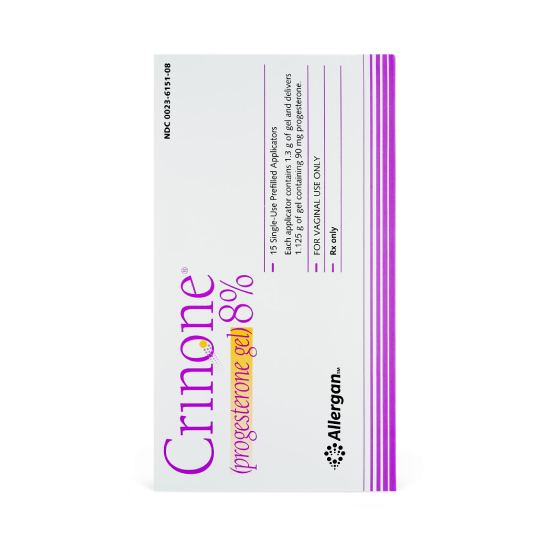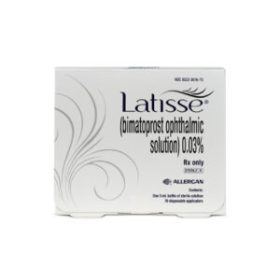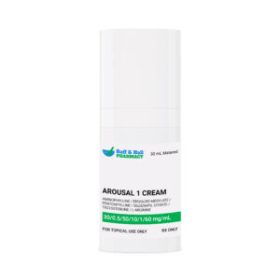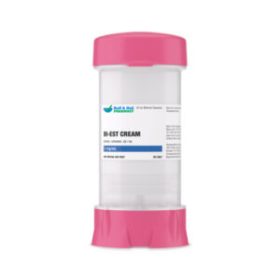This product is available solely through our 503A Compounding Pharmacy, ensuring personalized care and precision in every order. Please note that a valid prescription is required for purchase. If you do not have an account, please contact us.
Crinone Gel (Each) †
† commercial product
A naturally produced progestin is progesterone. It is produced in the ovaries, testes, placenta, and adrenal cortex in the body. Progesterone can be taken orally, parenterally, or vaginally. Chiefly used to treat amenorrhea and aberrant uterine bleeding, the hormone also helps to stop endometrial hyperplasia in postmenopausal women on estrogen treatment. Originally used as a contraceptive, the medication is occasionally used off-label for premenstrual dysphoric disorder (PMDD). Early pregnancy failure in women with corpus luteum insufficiency, including those using assisted reproductive technology (ART), can be prevented with progesterone. Progesterone also aids In particular patients, lower the risk for early birth. The effectiveness of the medication in lowering the risk for preterm birth in multiple gestation pregnancies is still unknown. Originally offered medicinally in 1939, progesterone predates the current FDA medication approval process; the injection and several bulk extemporaneous products were Long accessible have been compounding of vaginal suppositories and other dosages forms. A progesterone-containing intrauterine device was available for contraception, but it is no longer promoted. Oral micronized progesterone capsules were first FDA-approved in May 1998; a progesterone vaginal gel was FDA-approved for Assisted Reproductive use in May 1997. A progesterone vaginal insert approved by the FDA in June 2007 was used for this purpose. Technology (ART) program
Produced by the ovary, placenta, and adrenal gland, progesterone is a naturally occurring steroid. Progesterone turns a proliferative endometrium into a secretory endometrium in the presence of enough oestrogen. Decidual tissue grows thanks in large part to progesterone, whose impact on the differentiation of stroma and glandular epithelia has been very much researched.Progesterone keeps the pregnancy once an embryo is inserted. Normal or nearly normal endometrial responses to oral estradiol and intramuscular progesterone have been observed. in women who are functional but agonadal throughout their sixth decade of life. Administering progesterone lowers circulating levels of gonadotropins.
In women with secondary amenorrhea, progesterone can be used to reach normal progesterone levels. Irregular menstruation may follow if a woman’s body does not generate enough progesterone. Consequently, progesterone may assist premenopausal women with such anomalies in restoring regular menstrual cycles.
When administered to a menopausal lady, progesterone’s main purpose is for a protective effect that lowers the risk of endometrial hyperplasia when used. When micronized oral progesterone is used in regimens for hormone replacement therapy (HRT), it seems not to have detrimental effects on serum lipid profiles.
Historically, progesterone has also been employed as a contraceptive, even in intrauterine contraceptive devices (IUDs). The primary contraceptive effect of exogenous progestins includes midcycle luteinizing hormone (LH) suppression. At the cellular level, progestins bind to the progesterone receptor after freely entering target cells. Target cells include the hypothalamus, the pituitary gland, the mammary gland, and the female reproductive tract. Progestins slow the release frequency of gonadotropin releasing hormone (GnRH) from the hypothalamus once they are bound to the receptor and dampen the preovulatory LH surge. therefore stopping ovulation and follicular maturity. The contraceptive impact might result from other processes as well. Other effects of progestins include changes in the endometrium that could impede implantation and an increase in cervical mucus viscosity thereby blocking sperm travel into the uterus.
Progesterone is not suitable for everyone. It should not be used by women with breast cancer or cancers of the reproductive organs, or those with unexplained vaginal bleeding. It can also affect hormonally sensitive cancers. When combined with estrogen in hormone replacement therapy (HRT), it may slightly increase the risk of breast cancer, especially after several years of use. Regular breast exams and mammograms are recommended for women using these hormones.
Progesterone may also raise the risk of blood clots, strokes, and heart problems, particularly in older women or those with risk factors like smoking, obesity, or diabetes. It should be used with caution in people with heart, kidney, or lung issues. It may cause mood changes, migraines, or seizures in some patients.
High doses of progesterone can impair fertility during treatment, and certain forms should not be used during pregnancy except under specialized care. Some formulations can reduce milk production, so breastfeeding mothers should consult their healthcare provider.
Selected progesterone products are explicitly designated for use to offer luteal support during early pregnancy. Studies of animals given progesterone orally, vaginally, or in utero have not revealed any evidence of harm to the fetus. Early pregnancy may be supported by progesterone vaginal gel as part of an Assisted Reproductive Technology (ART) program; should pregnancy happen, the gel is Normally kept on 10 to 12 weeks until the baby can be maintained by placental progesterone production. Also used for up to ten weeks in ART, progesterone vaginal implants should only be used under the supervision of an ART specialist during early pregnancy. Data indicate that vaginal progesterone particularly during high-risk singleton pregnancy is effective in avoiding preterm delivery and related neonatal consequences; usually started at 16 to 24 weeks gestation beginning and 34 weeks gestation continues. Should there be an ectopic pregnancy, a missing or incomplete abortion, or during pregnancy diagnostic tests, progesterone should not be used.
Detectable levels of medicine have been found in the milk of moms taking progestational drugs. It is unknown how this will affect the breastfeeding infant. Generally speaking, progestins have not hurt lactation. Think about the maternal clinical need for progesterone and the possible negative consequences for the breastfed baby in light of the developmental and health advantages of breastfeeding.
Store this medication in its original container at 68°F to 77°F (20°C to 25°C) and away from heat, moisture and light. Keep all medicine out of the reach of children. Throw away any unused medicine after the beyond use date. Do not flush unused medications or pour down a sink or drain.
- Endometrin (progesterone) vaginal insert package insert. Hunt Valley, MD: Pharmaceutics International, Inc.; 2014 Jun.
- Prochieve (progesterone) vaginal gel package insert. Livingston, NJ: Columbia Laboratories, Inc.; 2009 Nov.
- Crinone (progesterone vaginal gel) package insert. Parsippany, NJ: Watson Pharma, Inc.; 2011 Dec.
- Fonseca EB, Celik E, Parra M, et al. Progesterone and the risk of preterm birth among women with a short cervix. N Engl J Med 2007;357:462-8.
- ACOG Committee on Obstetric Practice. Committee Opinion: use of progesterone to reduce preterm birth. Obstet Gynecol 2003;102:1115-6.
- Rode L, Tabor A. Prevention of preterm delivery in twin pregnancy. Best Pract Res Clin Obstet Gynaecol 2014;28:273-83.
- Prometrium (micronized progesterone capsules) package insert. North Chicago, IL: AbbVie Inc.; 2013 Sept.
- Tavaniotou A, Smitz J, Bourgain C, et al. Comparison between different routes of progesterone administration as luteal phase support in infertility treatments. Hum Reprod Update 2000;6:139-48.
- Hassan SS, Romero R, Vidyadhari D, et al; PREGNANT Trial. Vaginal progesterone reduces the rate of preterm birth in women with a sonographic short cervix: a multicenter, randomized, double-blind, placebo-controlled trial. Ultrasound Obstet Gynecol. 2011;38:18-31.
- da Fonseca EB, Bittar RE, Carvalho MB, et al. Prophylactic administration of progesterone by vaginal suppository to reduce the incidence of spontaneous preterm birth in women at increased risk: a randomized, placebo-controlled double-blind study. Am J Obstet Gynecol 2003;188:419-24.
- Progesterone in sesame oil injection package insert. Parsippany, NJ: Actavis Pharmaceuticals; 2014 Sept.
- Chlebowski RT, Hendrix SL, Langer RD, et al. Influence of Estrogen Plus Progestin on Breast Cancer and Mammography in Healthy Postmenopausal Women: The Women’s Health Initiative Randomized Trial. JAMA 2003;289:3243-53.
- Rossouw JE, Anderson GL, Prentice RL, et al. The Writing Group for the Women’s Health Initiative Investigators. Risks and benefits of estrogen plus progestin in healthy postmenopausal women: principal results From the Women’s Health Initiative randomized controlled trial. JAMA 2002;288:321-333.
- American Academy of Pediatrics (AAP) Committee on Drugs. Transfer of drugs and other chemicals into human milk. Pediatrics 2001;108:776-89.
- Cushman M, Kuller LH, Prentice R, et al. Estrogen plus progestin and risk of venous thrombosis. JAMA. 2004;292:1573-1580.
- Hsia J, Langer RD, Manson JE, et al. Conjugated equine estrogens and coronary heart disease. The Women’s Health Initiative. Arch Intern Med. 2006;166:357-365.
- The Heart and Estrogen/progestin Replacement Study (HERS) Research Group. Randomized trial of estrogen plus progestin for secondary prevention of coronary heart disease in postmenopausal women. JAMA 1998;280:605-13.
- Grady D, Herrington D, Bittner V, et al. Cardiovascular disease outcomes during 6.8 years of hormone therapy: Heart and Estrogen/progestin Replacement Study follow-up (HERS II). JAMA 2002;288:49-57.
- Rossoun JE, Prentice RL, Manson JE. Postmenopausal hormone therapy and risk of cardiovascular disease by age and years since menopause. JAMA. 2007;297:1465-1477.
- Shumaker SA, Legault C, Rapp SR, et al. Estrogen plus progestin and the incidence of dementia and mild cognitive impairment in postmenopausal women. The Women’s Health Initiative Memory Study: A randomized controlled trial (WHIMS). JAMA 2003;289:2651-62.
- Progesterone capsule package insert. High Point, NC: Banner Pharmacaps Inc; 2013 Nov.
- Stefanick ML, Anderson GL, Margolis KL, et al. Effects of conjugated equine estrogens on breast cancer and mammography screening in postmenopausal women with hysterectomy. JAMA 2006;295:1647-57.
- Lacey JV, Mink PJ, Lubin JH, et al. Menopausal hormone replacement therapy and risk of ovarian cancer. JAMA 2002;288:334-341.
- The 2017 hormone therapy position statement of The North American Menopause Society. Menopause. 2017 Jun 22.
- Grady D, Rubin SM, Petitti DB, et al. Hormone therapy to prevent disease and prolong life in postmenopausal women. Ann Intern Med 1992;117:1016-37.





